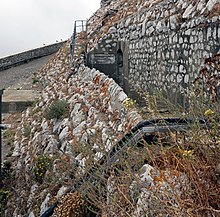| Spyglass Battery | |
|---|---|
| Part of Fortifications of Gibraltar | |
| Gibraltar | |
 The Levanter Cloud streaming over Spy Glass Battery | |
| Site information | |
| Type | Artillery Battery |
| Owner | Ministry of Defence |
| Controlled by | Ministry of Defence |
| Location | |
 | |
| Coordinates | 36°07′38″N5°20′39″W / 36.127318°N 5.344154°W |
Spy Glass Battery or Spyglass Battery was originally a high angle artillery battery in the British Overseas Territory of Gibraltar. The battery is mounted high on the rock [1] to give extra range and protection. The battery was still in use during the Second World War as a listening post and site for a Bofors Gun.





